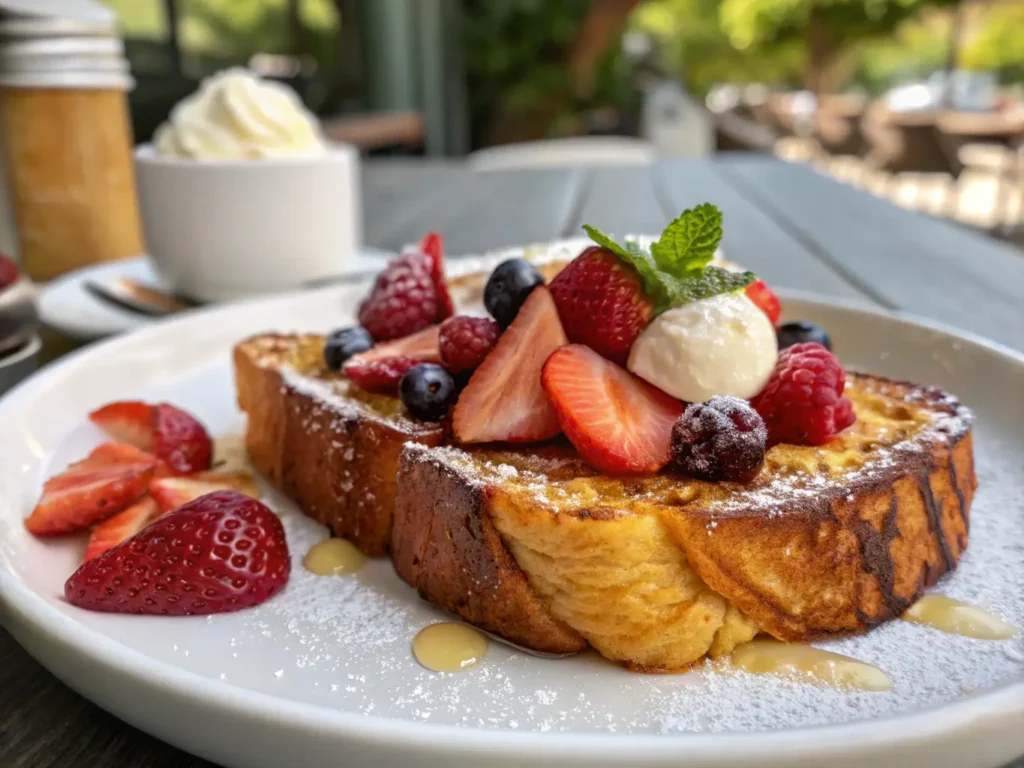Table of Contents
Croissant French toast is a decadent, buttery twist on the classic breakfast dish, elevating it to an entirely new level of indulgence. Perfect for brunch, special holidays, or any occasion where you want to impress your guests, this dish combines the crispiness of French toast with the light, flaky texture and rich flavor of croissants. Whether you’re hosting a brunch gathering or simply treating yourself to a special breakfast, croissant French toast is sure to delight. Its versatility and deliciousness make it an appealing dish for those who love gourmet twists on traditional meals. This guide will walk you through how to make croissant French toast from scratch, offering tips, variations, and ideas for perfecting this dish every time.
What is Croissant French Toast?
Croissant French toast is a creative and luxurious variation of the traditional French toast, where croissants replace the usual bread. These buttery, flaky pastries soak up the rich custard mixture and cook up into a golden-brown masterpiece with crispy edges and a soft interior. The beauty of this dish lies in the contrast of textures—the outside is crisp and slightly caramelized, while the inside remains soft and custardy. By using croissants, this French toast becomes even more indulgent, transforming it into a brunch or breakfast item worthy of celebration.
A Decadent Take on Traditional French Toast
Traditional French toast is typically made with thick slices of bread, dipped in a mixture of eggs, milk, and spices before being pan-fried. However, by swapping in croissants, you create a richer, more buttery flavor that enhances the dish’s overall taste. The flaky texture of croissants soaks up the egg mixture without falling apart, making each bite a perfect balance of sweetness and richness.
Why Use Croissants Instead of Bread?
The unique characteristics of croissants make them the perfect base for this French toast variation. The butter content in croissants gives the dish an extra level of flavor, while their flaky layers absorb the custard mixture more efficiently than regular bread, resulting in a lighter, airier texture. This combination of crispy exterior and soft, buttery interior elevates the experience of French toast and transforms it into a truly indulgent meal.
Popularity of Croissant French Toast
In recent years, croissant French toast has risen in popularity, especially as a trendy brunch item in cafes and home kitchens. Its unique texture, rich flavor, and ability to be dressed up with a variety of toppings make it a favorite for anyone looking to impress guests or enjoy an elevated breakfast. With its gourmet appeal, croissant French toast has become a go-to dish for those seeking a luxurious yet simple breakfast or brunch experience.
Ingredients for Croissant French Toast
Making the perfect croissant French toast requires just a handful of quality ingredients. While the basic ingredients are simple, the key to success lies in the balance of these elements and the quality of the croissants used.
Croissants
For the best results, use fresh croissants or day-old croissants that have had time to slightly harden, allowing them to better absorb the egg mixture. If you prefer store-bought croissants, choose those with a buttery flavor and flaky texture. Stale croissants work well because they will hold up better during the soaking process without becoming too soggy. Cut the croissants into halves or quarters, depending on the size of your pan or griddle.

Egg Mixture
The core of this recipe is the egg mixture that gives the croissants their custard-like texture. To make the mixture:
- Eggs: A few large eggs create the base of the custard, providing structure and richness.
- Milk or Cream: For a creamier texture, you can use whole milk, half-and-half, or heavy cream.
- Sugar: A bit of sugar adds sweetness. You can adjust the amount based on how sweet you prefer your French toast.
- Vanilla: A splash of vanilla extract adds a warm, comforting aroma and flavor.
- Spices: Adding ground cinnamon and a pinch of nutmeg enhances the flavor, giving it a warm, spiced note that pairs beautifully with the croissants.
Optional Add-Ins
If you want to add more flavor or a unique twist, consider these optional ingredients:
- Zests: A bit of lemon or orange zest can brighten the flavor of the dish.
- Liqueurs: A splash of Grand Marnier or Amaretto can add a sophisticated touch to the custard mixture.
- Spices: Ground cinnamon, cloves, and allspice are popular additions for an extra aromatic flavor.
Toppings and Garnishes
Once your croissant French toast is cooked, you can top it with an array of sweet and savory garnishes, such as:
- Powdered sugar: A light dusting adds a touch of sweetness and a decorative finish.
- Maple syrup: A classic topping, with its sweet and rich flavor, pairs perfectly with croissant French toast.
- Fresh fruit: Berries, banana slices, or caramelized apples complement the richness of the toast.
- Whipped cream: For an indulgent treat, top the French toast with freshly whipped cream.
Equipment Needed for the Recipe
To make croissant French toast to perfection, you will need the following kitchen tools:
Cooking Essentials
- Nonstick Skillet: A nonstick skillet is ideal for cooking croissant French toast, as it ensures the toast cooks evenly and doesn’t stick. You can also use a griddle for cooking multiple pieces at once or a baking sheet if you prefer to bake it in the oven.
- Spatula: A flat spatula is essential for flipping the croissants without damaging them.
Prep Tools
- Mixing Bowl: A large mixing bowl is necessary for whisking together the egg mixture.
- Whisk: Use a whisk to ensure the ingredients are well-combined and the eggs are fully beaten.
- Knife: A sharp knife is needed to slice the croissants into manageable pieces.
Step-by-Step Recipe for Croissant French Toast
Here’s how to make croissant French toast that’s golden, crispy, and perfectly cooked.
Preparing the Egg Mixture
- In a large mixing bowl, crack 4 large eggs and whisk them until smooth.
- Add 1 cup of milk (or heavy cream for a richer version) and whisk until combined.
- Stir in 2 tablespoons of sugar, 1 teaspoon of vanilla extract, and 1 teaspoon of ground cinnamon. For added flavor, consider adding a pinch of nutmeg or a splash of Grand Marnier.
- Whisk the mixture thoroughly to ensure all ingredients are incorporated evenly.
Dipping the Croissants
- Slice day-old croissants into halves or quarters, depending on their size.
- Dip each piece of croissant into the egg mixture, ensuring that both sides are coated. Be careful not to let the croissant soak too long, as this can make it too soggy.
- Place the dipped croissant pieces onto a plate or tray to rest while you heat the skillet.
Cooking the Croissant French Toast
- Heat a nonstick skillet over medium heat and add 1-2 tablespoons of butter or oil. Allow it to melt and coat the skillet evenly.
- Once the skillet is hot, carefully place the soaked croissant pieces onto the skillet.
- Cook the croissants for 2-3 minutes per side, or until they are golden brown and crispy on the outside.
- Continue cooking in batches, adding more butter or oil as needed.
Serving the Dish
- Once the French toast is cooked, transfer the croissant pieces to a serving platter.
- Top with powdered sugar, maple syrup, and fresh fruit or whipped cream.
- Serve immediately while still warm and crispy.
Tips for Perfect Croissant French Toast
Choosing the Right Croissants
For the best results, use slightly stale croissants. This helps them absorb the custard mixture without falling apart. Fresh croissants work too, but slightly aged croissants give a better texture.
Balancing Sweetness
The sweetness of the custard should be balanced with the sweetness of the toppings. Adjust the sugar in the custard depending on your personal preference for sweetness.
Cooking Temperature
To avoid burning the exterior while ensuring the interior is cooked, medium heat is ideal. If the heat is too high, the croissant may cook too quickly on the outside while remaining raw on the inside.
Variations of Croissant French Toast
Stuffed Croissant French Toast
Add a filling between croissant layers, such as cream cheese, Nutella, or fruit preserves for a decadent twist.

Savory Croissant French Toast
For a savory version, incorporate herbs, cheese, and ham or bacon into the croissants before soaking them in the custard.
Chocolate-Dipped French Toast
For chocolate lovers, dip the croissants in melted chocolate or sprinkle chocolate chips over the French toast after cooking.
Vegan Croissant French Toast
Use plant-based croissants, almond milk, and egg substitutes for a delicious vegan version of this dish.
Serving Suggestions for Croissant French Toast
Brunch Pairings
Serve your croissant French toast with a cup of freshly brewed coffee, mimosas, or fresh juice for the perfect brunch experience.
Sides to Serve
Pair with bacon, sausage, or a fruit salad for a complete meal.
Creative Presentations
For an eye-catching presentation, stack the French toast in layers or serve it on a charcuterie-style platter with various toppings.
Health Benefits and Indulgent Balance
Nutritional Value of Croissants
While croissant French toast is indulgent, you can enjoy it in moderation. Croissants provide a good amount of carbs and fats, but they also offer energy to fuel your day.
Customizing for Dietary Needs
To make this dish lighter, try substituting low-fat milk and reducing the sugar. For gluten-free versions, use gluten-free croissants or bread alternatives.
Making It a Balanced Meal
For a balanced meal, add a protein-rich side, such as scrambled eggs or tofu, to accompany the French toast.
Common Mistakes to Avoid
Over-Soaking Croissants
Avoid letting the croissants soak for too long in the egg mixture to prevent sogginess.
Using Low Heat
Low heat can result in uneven cooking. Medium heat ensures a crispy exterior and perfectly cooked interior.
Skipping the Resting Step
Allow the French toast to rest slightly before serving to achieve the best texture.
FAQs
Can I use flavored croissants for this recipe?
Yes, flavored croissants, such as almond or chocolate croissants, can add an extra layer of flavor.
How do I store leftovers?
Store any leftovers in an airtight container in the refrigerator for up to 2 days. Reheat in a skillet for best results.
Can I make croissant French toast ahead of time?
It’s best served fresh, but you can prepare the egg mixture and croissants the night before and refrigerate them. Cook them the next morning.
What are good gluten-free croissant alternatives?
You can use gluten-free bread or croissant alternatives for a gluten-free version of this recipe.
How do I make the dish less sweet?
Reduce the sugar in the custard and use less syrup or opt for sugar-free toppings.
Can I bake croissant French toast instead of frying it?
Yes, baking is an option. Place the soaked croissants on a baking sheet and bake at 350°F (175°C) for about 15 minutes, flipping halfway through.
Conclusion
Croissant French toast is a perfect blend of elegance, flavor, and indulgence, transforming a simple breakfast into a gourmet meal. Whether you enjoy it for brunch, special occasions, or as a comforting treat, this dish is easy to prepare and incredibly satisfying. Try experimenting with different variations and toppings, and you’ll soon have your new favorite breakfast recipe.

